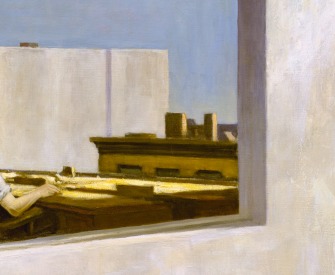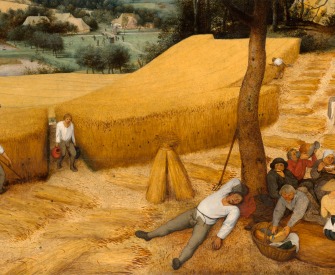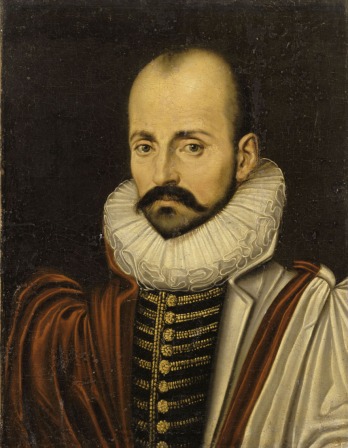Monks were divided into two classes: the cenobites, who lived under a common and regular discipline, and the anchorites, who indulged their unsocial, independent fanaticism. The most devout, or the most ambitious, of the spiritual brethren renounced the convent, as they had renounced the world. The fervent monasteries of Egypt, Palestine, and Syria were surrounded by a Laura, a distant circle of solitary cells, and the extravagant penance of the hermits was stimulated by applause and emulation. They sunk under the painful weight of crosses and chains, and their emaciated limbs were confined by collars, bracelets, gauntlets, and greaves of massy and rigid iron. All superfluous encumbrance of dress they contemptuously cast away, and some savage saints of both sexes have been admired whose naked bodies were only covered by their long hair. They aspired to reduce themselves to the rude and miserable state in which the human brute is scarcely distinguished above his kindred animals, and a numerous sect of anchorites derived their name from their humble practice of grazing in the fields of Mesopotamia with the common herd. They often usurped the den of some wild beast whom they affected to resemble; they buried themselves in some gloomy cavern which art or nature had scooped out of the rock—and the marble quarries of Thebais are still inscribed with the monuments of their penance. The most perfect hermits are supposed to have passed many days without food, many nights without sleep, and many years without speaking, and glorious was the man (I abuse that name) who contrived any cell, or seat, of a peculiar construction, which might expose him, in the most inconvenient posture, to the inclemency of the seasons.
Among these heroes of the monastic life, the name and genius of Simeon Stylites have been immortalized by the singular invention of an aerial penance. At the age of thirteen, the young Syrian deserted the profession of a shepherd and threw himself into an austere monastery. After a long and painful novitiate, in which Simeon was repeatedly saved from pious suicide, he established his residence on a mountain about thirty or forty miles to the east of Antioch. Within the space of a mandra, or circle of stones, to which he had attached himself by a ponderous chain, he ascended a column, which was successively raised from the height of nine to that of sixty feet from the ground. In this last and lofty station, the Syrian anchorite resisted the heat of thirty summers and the cold of as many winters. Habit and exercise instructed him to maintain his dangerous situation without fear or giddiness, and successively to assume the different postures of devotion. He sometimes prayed in an erect attitude with his outstretched arms in the figure of a cross, but his most familiar practice was that of bending his meager skeleton from the forehead to the feet, and a curious spectator, after numbering 1,244 repetitions, at length desisted from the endless account. The progress of an ulcer in his thigh might shorten, but it could not disturb, this celestial life—and the patient hermit expired without descending from his column.
The monastic saints, who excite only the contempt and pity of a philosopher, were respected, and almost adored, by the prince and people. Successive crowds of pilgrims from Gaul and India saluted the divine pillar of Simeon; the tribes of Saracens disputed in arms the honor of his benediction; the queens of Arabia and Persia gratefully confessed his supernatural virtue; and the angelic hermit was consulted by the younger Theodosius in the most important concerns of the church and state. His remains were transported from the mountain of Telenissa by a solemn procession of the patriarch, the master general of the East, six bishops, twenty-one counts or tribunes, and six thousand soldiers, and Antioch revered his bones, as her glorious ornament and impregnable defense. The fame of the apostles and martyrs was gradually eclipsed by these recent and popular anchorites; the Christian world fell prostrate before their shrines, and the miracles ascribed to their relics exceeded, at least in number and duration, the spiritual exploits of their lives. But the golden legend of their lives was embellished by the artful credulity of their interested brethren, and a believing age was easily persuaded that the slightest caprice of an Egyptian or a Syrian monk had been sufficient to interrupt the eternal laws of the universe. The favorites of heaven were accustomed to cure inveterate diseases with a touch, a word, or a distant message—and to expel the most obstinate demons from the souls, or bodies, which they possessed. They familiarly accosted, or imperiously commanded, the lions and serpents of the desert, infused vegetation into a sapless trunk, suspended iron on the surface of the water, passed the Nile on the back of a crocodile, and refreshed themselves in a fiery furnace. These extravagant tales, which display the fiction—without the genius—of poetry, have seriously affected the reason, the faith, and the morals of the Christians.
From The History of the Decline and Fall of the Roman Empire. The shepherd turned monk received the epithet “Stylites,” from the Greek word for “pillar,” because he was the first hermit to dwell on such a site. Pilgrims came to him for counsel, healing, and spiritual enlightenment. His austere example inspired extreme asceticism in subsequent generations of hermits, and there were stylites in Russia as late as the nineteenth century.
Back to Issue




